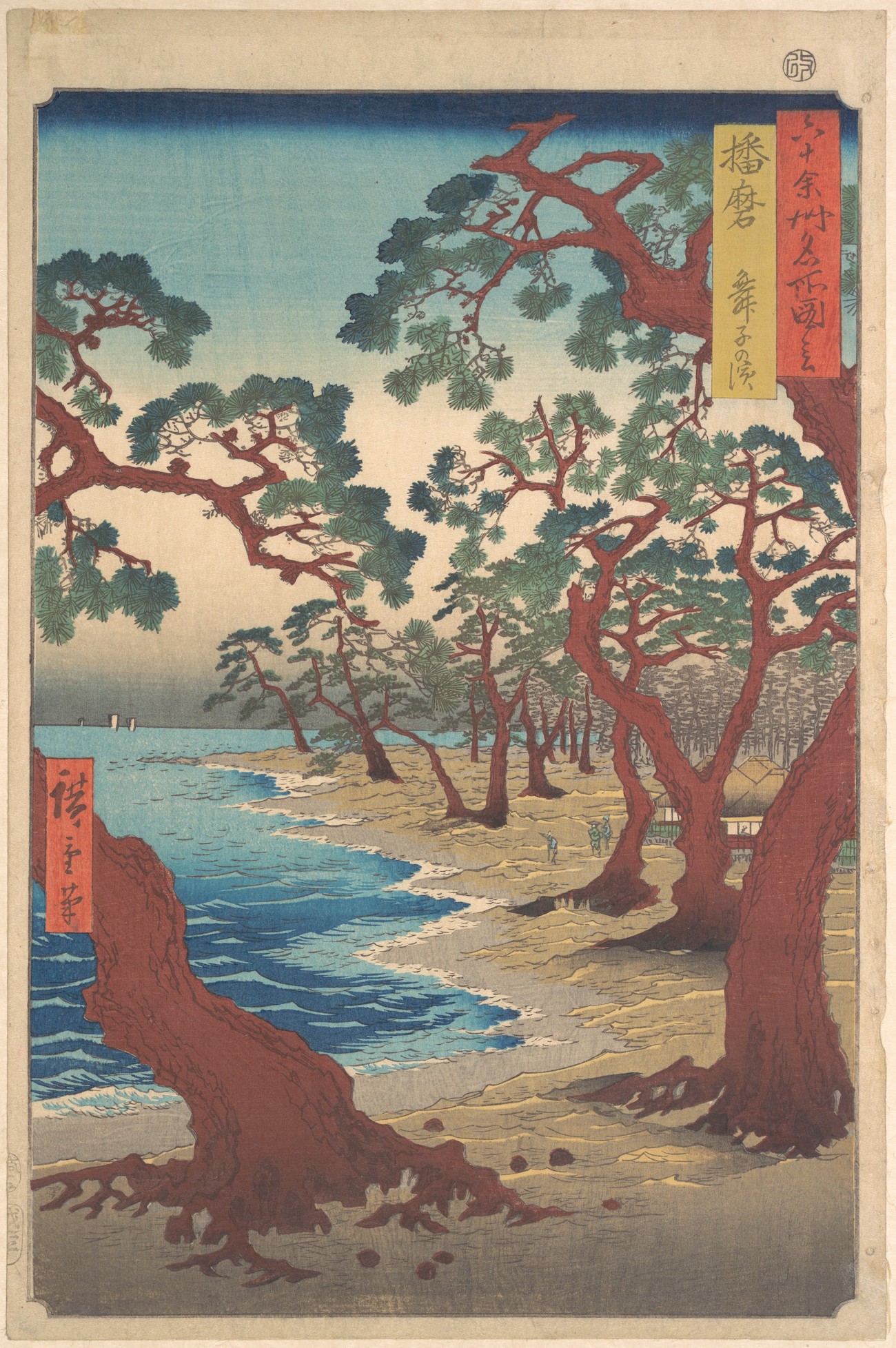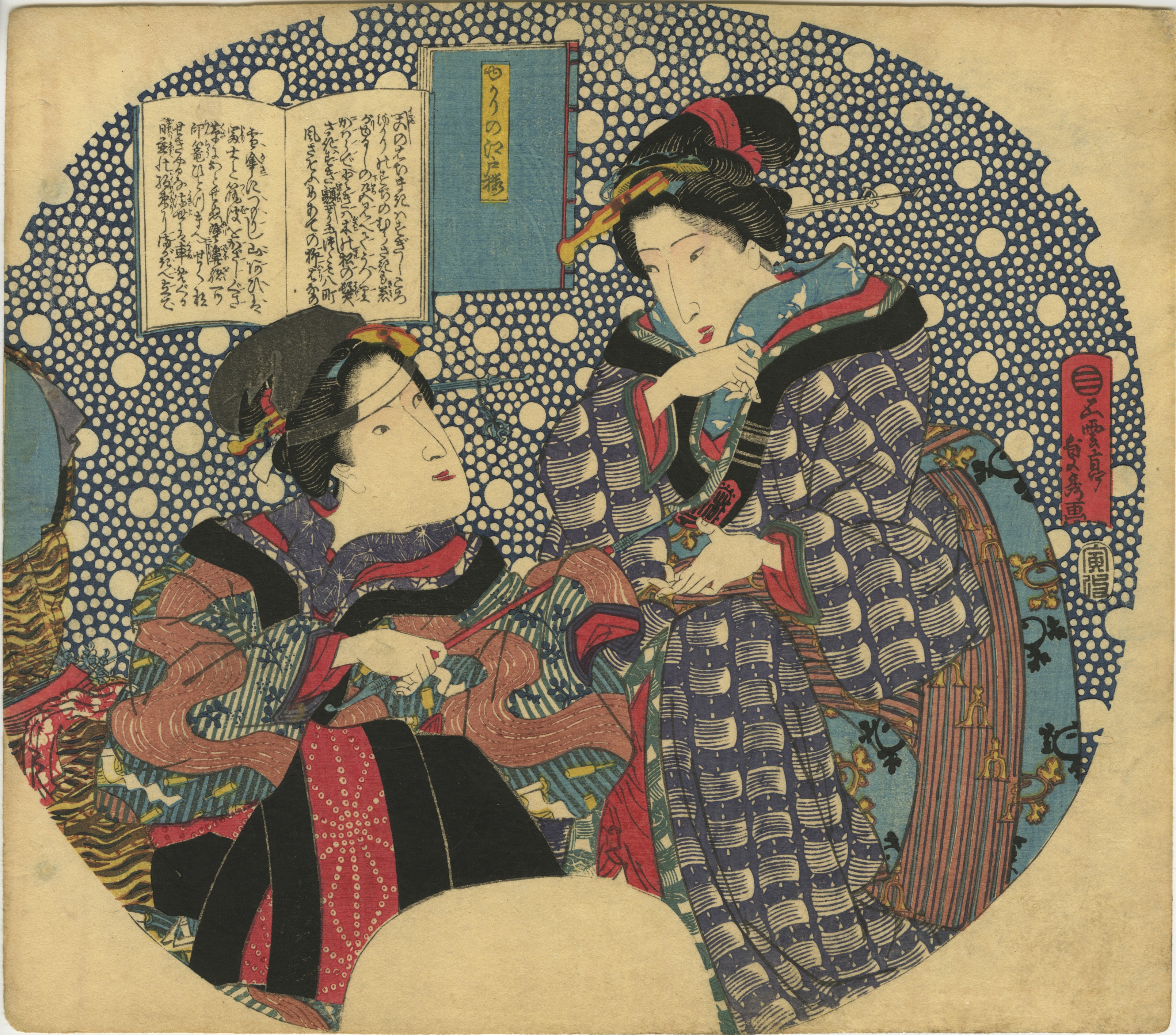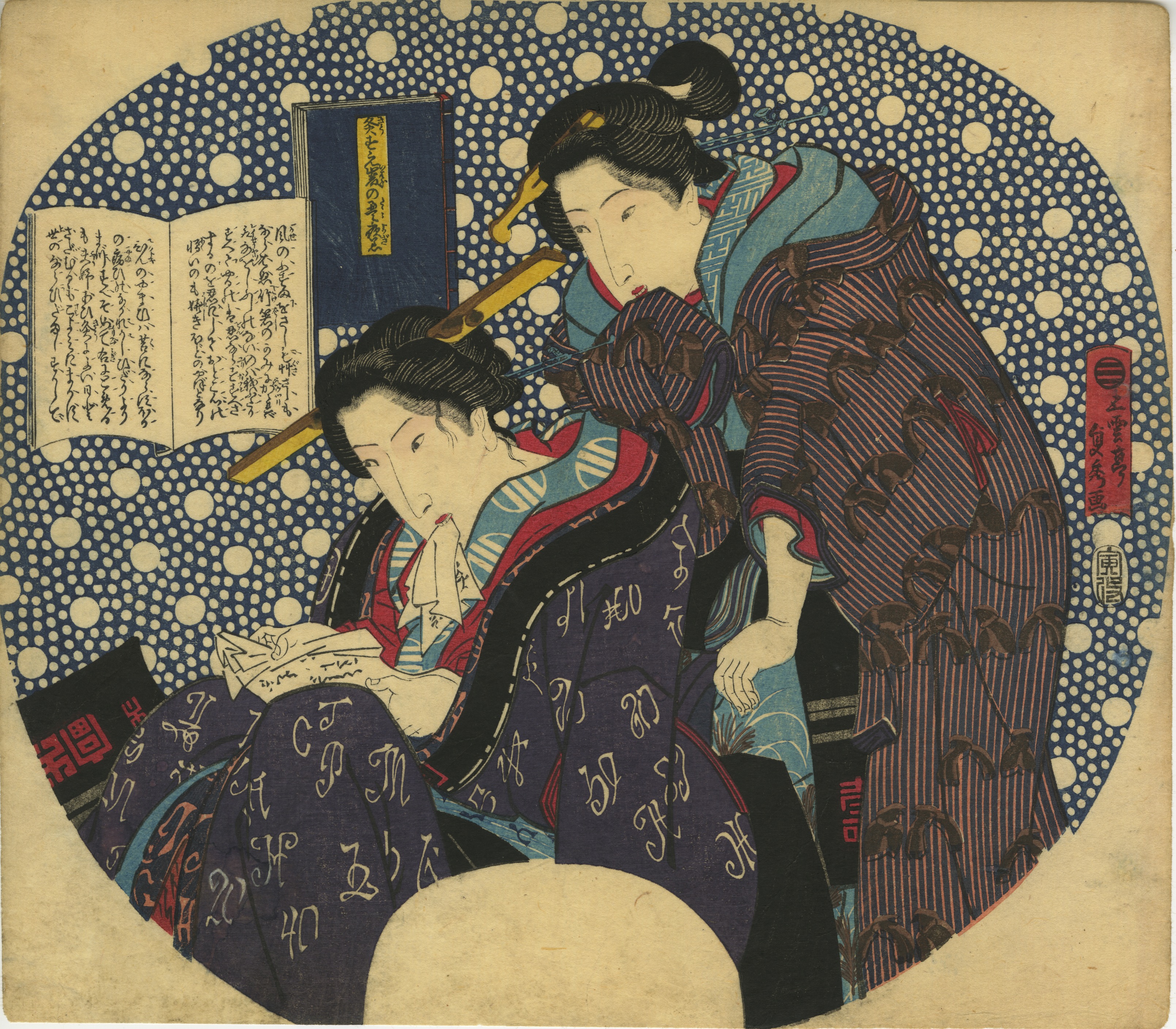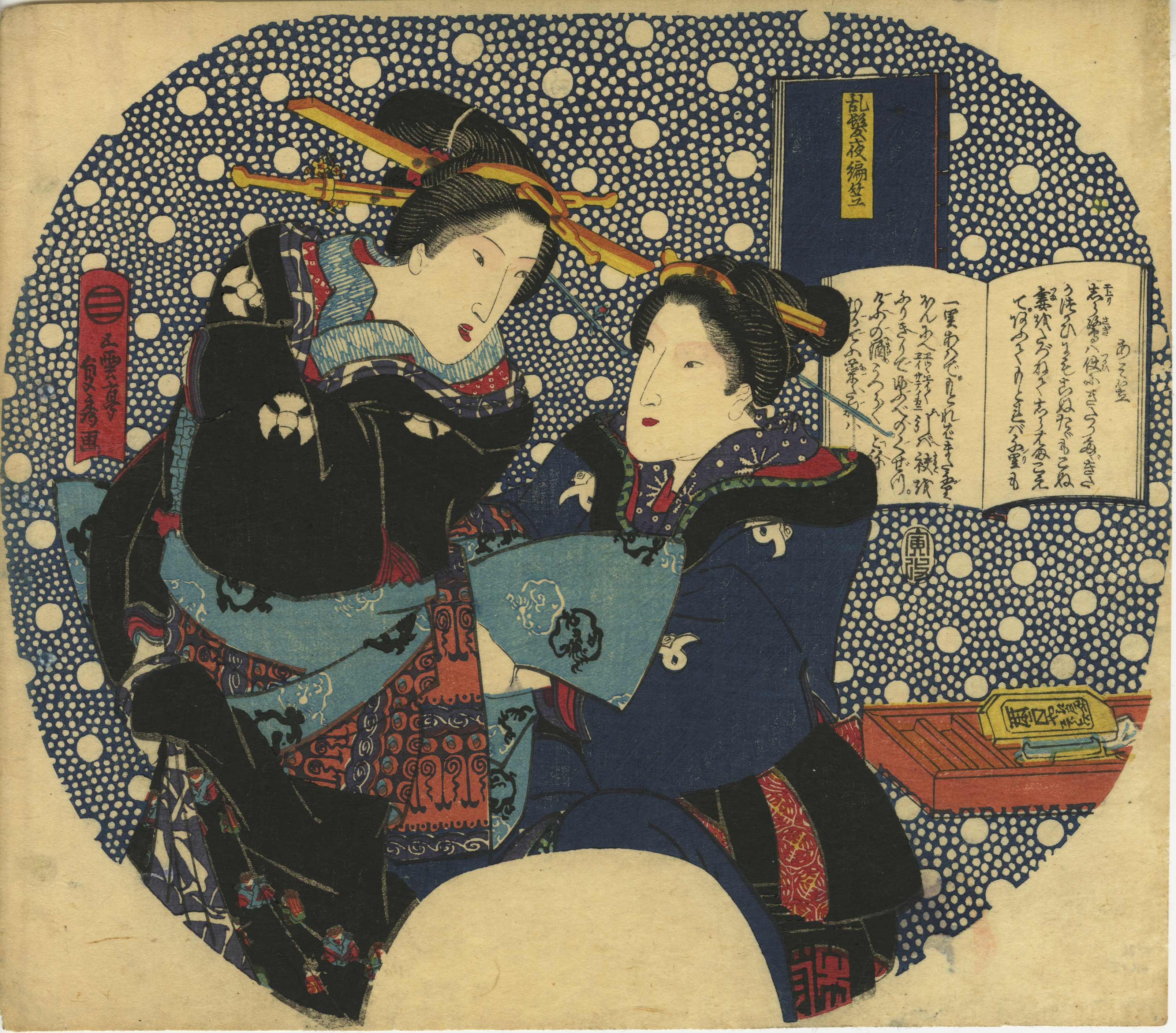-
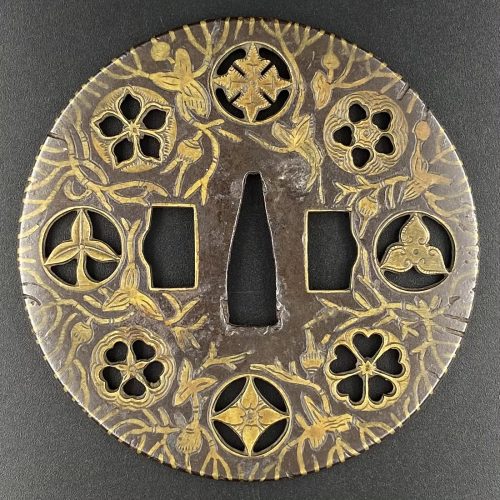 Iron tsuba of round form, tapering from centre to the rim, decorated with eight roundels – circular emblems of flowers and/or family crests (mon) made of cast brass, pierced and chiselled in kebori, and with flat brass inlay (hira-zōgan) of water plantain (omodaka) and seaweed all over the plate. Hitsu-ana outlined in brass. Four positive silhouette roundels are 3-, 6-, 9-, and 12 – pointing crests/flowers; four negative silhouette roundels – bellflower, cherry and plum blossoms. Yoshirō school (Kaga-Yoshirō). Unsigned. The Momoyama or early Edo period, end of the 16th to the first half of the 17th century (1574-1650). Size: H: 88.3 mm; W: 88.7 mm; Thickness 4.0 mm (Seppa-dai), 3,2 cm (rim). Other Kaga-Yoshiro tsuba in this collection: TSU-0334: 7.7 cm; TSU-0342.2017: 89.6 cm; TSU-0344: 8.1 cm; TSU-0329: 8.0 cm; TSU-0376.2018: 8.1 cm; TSU-0379.2018: 8.2 cm. We see that the usual size is about 8 cm; larger pieces, such as this one and TSU-0342.2017 dedicated to Hachiman, are rare. Article about Yoshiro tsuba.
Iron tsuba of round form, tapering from centre to the rim, decorated with eight roundels – circular emblems of flowers and/or family crests (mon) made of cast brass, pierced and chiselled in kebori, and with flat brass inlay (hira-zōgan) of water plantain (omodaka) and seaweed all over the plate. Hitsu-ana outlined in brass. Four positive silhouette roundels are 3-, 6-, 9-, and 12 – pointing crests/flowers; four negative silhouette roundels – bellflower, cherry and plum blossoms. Yoshirō school (Kaga-Yoshirō). Unsigned. The Momoyama or early Edo period, end of the 16th to the first half of the 17th century (1574-1650). Size: H: 88.3 mm; W: 88.7 mm; Thickness 4.0 mm (Seppa-dai), 3,2 cm (rim). Other Kaga-Yoshiro tsuba in this collection: TSU-0334: 7.7 cm; TSU-0342.2017: 89.6 cm; TSU-0344: 8.1 cm; TSU-0329: 8.0 cm; TSU-0376.2018: 8.1 cm; TSU-0379.2018: 8.2 cm. We see that the usual size is about 8 cm; larger pieces, such as this one and TSU-0342.2017 dedicated to Hachiman, are rare. Article about Yoshiro tsuba. -
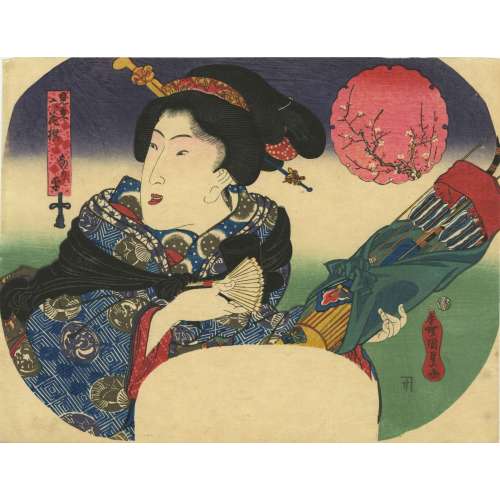 Artist: Utagawa Kunisada [歌川 国貞] a.k.a. Utagawa Toyokuni III [三代歌川豊国] (Japanese, 1786 – 1865). Signed: Kōchō(rō) Kunisada ga (香蝶国貞画) in a red double-gourd cartouche. Publisher: Surugaya Sakujirō [駿河屋作次郎] (Japanese, fl. c. 1844 – 1865); Marks 06-005 | 501a. Single nanushi censor seal: Muramatsu (1843-6). The date is attributed to c. 1844. Title: Narihira [なり平]. Ariwara no Narihira [在原 業平] (Japanese, 825 – 880) – one of the Six Immortal Poets – The Rokkasen [六歌仙]. Series: A parody of six immortal poets [見立六花撰] (Mitate Rokkasen). Media: Untrimmed fan print (uchiwa-e), 227 x 293 mm, depicting a beautiful woman with a bow and arrows in her left hand. Series: Mitate Rokkasen [見立六花撰] – is sometimes interpreted as "A parody of six immortal poets" or "A comparison of six select flowers". [LIB-1212.2017] Robert Schaap. Kunisada: Imaging, drama and beauty. — Leiden: Hotei Publishing, 2016; pl. 28, p. 58. This is another fan print with another immortal poet, Bun'ya no Yasuhide [文屋 康秀] (Japanese, -d. 885?), from the same series, provided in the book:With special thanks to Horst Graebner for help with the description and date attribution: "The print can be dated to 1844: censor seal is Muramatsu (Muramatsu Genroku); he acted in 7/1844 and 4/1845 (and also later) as censor but Kunisada changed his name to Kunisada early in 1844."
Artist: Utagawa Kunisada [歌川 国貞] a.k.a. Utagawa Toyokuni III [三代歌川豊国] (Japanese, 1786 – 1865). Signed: Kōchō(rō) Kunisada ga (香蝶国貞画) in a red double-gourd cartouche. Publisher: Surugaya Sakujirō [駿河屋作次郎] (Japanese, fl. c. 1844 – 1865); Marks 06-005 | 501a. Single nanushi censor seal: Muramatsu (1843-6). The date is attributed to c. 1844. Title: Narihira [なり平]. Ariwara no Narihira [在原 業平] (Japanese, 825 – 880) – one of the Six Immortal Poets – The Rokkasen [六歌仙]. Series: A parody of six immortal poets [見立六花撰] (Mitate Rokkasen). Media: Untrimmed fan print (uchiwa-e), 227 x 293 mm, depicting a beautiful woman with a bow and arrows in her left hand. Series: Mitate Rokkasen [見立六花撰] – is sometimes interpreted as "A parody of six immortal poets" or "A comparison of six select flowers". [LIB-1212.2017] Robert Schaap. Kunisada: Imaging, drama and beauty. — Leiden: Hotei Publishing, 2016; pl. 28, p. 58. This is another fan print with another immortal poet, Bun'ya no Yasuhide [文屋 康秀] (Japanese, -d. 885?), from the same series, provided in the book:With special thanks to Horst Graebner for help with the description and date attribution: "The print can be dated to 1844: censor seal is Muramatsu (Muramatsu Genroku); he acted in 7/1844 and 4/1845 (and also later) as censor but Kunisada changed his name to Kunisada early in 1844."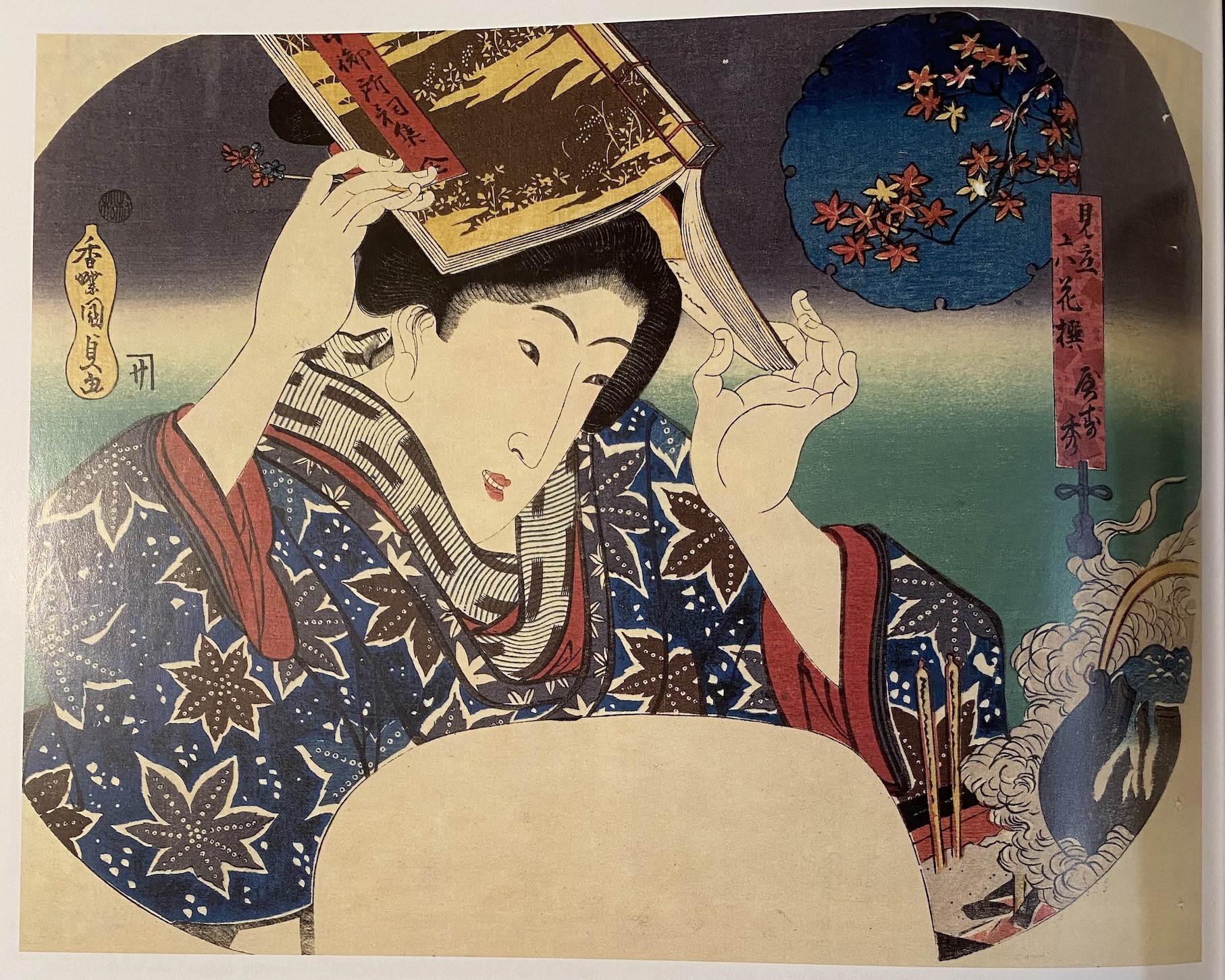
Robert Schaap, 2016.
-
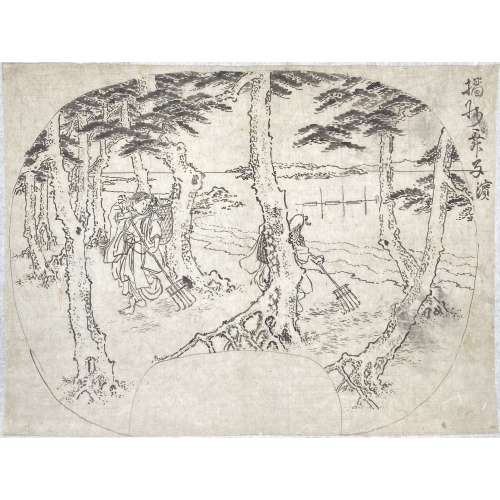 Artist: Veronica Miller attributes the drawing to Utagawa Sadahide [歌川 貞秀] (Japanese, 1807 – 1879), also known as Gountei Sadahide [五雲亭 貞秀]. A preparatory drawing for a fan print depicts two women raking pine needles along the scenic beach at Harima. Inscription at top right "Maiko Beach in Harima" (Harima Maiko no Hama) [播磨 舞子濱], which is now located in Hyōgo Prefecture. The view must be of the Akashi Strait, looking towards Awaji Island. Drawn on thin hanshita paper, mounted lightly at the top to a backing paper, but unbacked. Size: 240 x 319 mm. Attribution to Sadahide based on his design titled "Suma Bay: Matsukaze and Murasame" (see below):
Artist: Veronica Miller attributes the drawing to Utagawa Sadahide [歌川 貞秀] (Japanese, 1807 – 1879), also known as Gountei Sadahide [五雲亭 貞秀]. A preparatory drawing for a fan print depicts two women raking pine needles along the scenic beach at Harima. Inscription at top right "Maiko Beach in Harima" (Harima Maiko no Hama) [播磨 舞子濱], which is now located in Hyōgo Prefecture. The view must be of the Akashi Strait, looking towards Awaji Island. Drawn on thin hanshita paper, mounted lightly at the top to a backing paper, but unbacked. Size: 240 x 319 mm. Attribution to Sadahide based on his design titled "Suma Bay: Matsukaze and Murasame" (see below):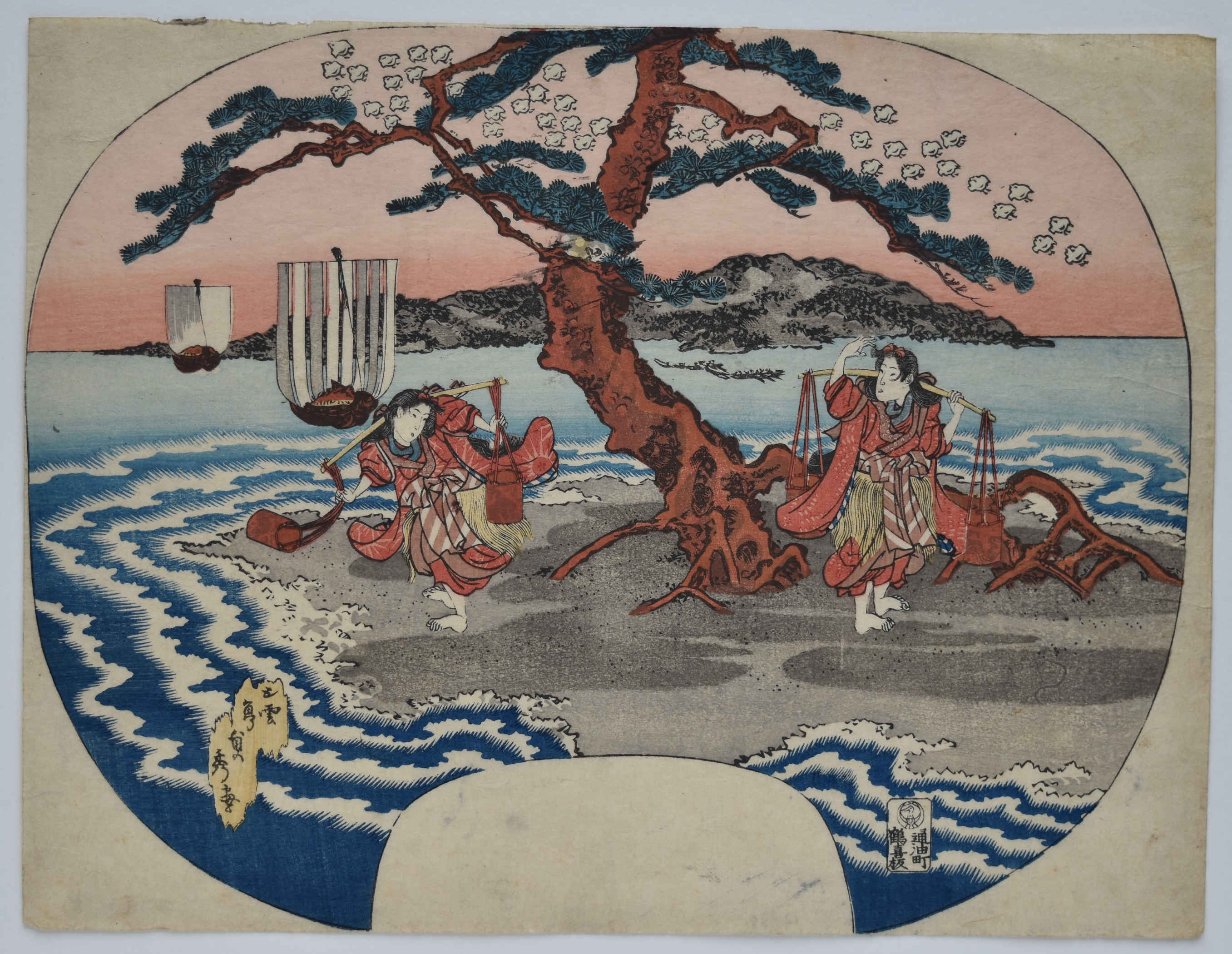 See also Maiko Beach, Harima Province, from the series Views of Famous Places in the Sixty-Odd Provinces,
See also Maiko Beach, Harima Province, from the series Views of Famous Places in the Sixty-Odd Provinces,
-
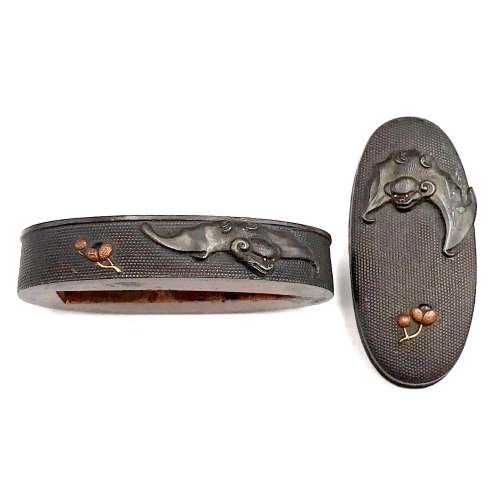
Fuchi-kashira made of shakudō carved and inlaid with gold and red copper with the design of a bat and a fruit (persimmon?). Nanako surface.
Fuchi: 37 x 19 x 7 mm. Kashira: 34 x 16 x 5 mm. Main material: shakudō. Other metals: gold and copper. Surface treatment: nanako-ji. -
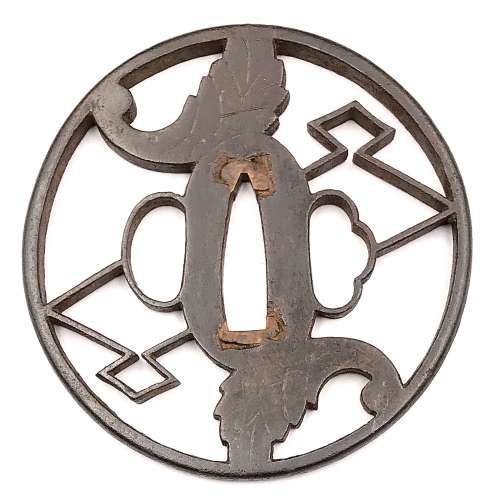 Iron tsuba of round form with design of ginger and double diamonds (myoga-ni-nigaibishi) in openwork (sukashi), details carved in kebori technique. Slightly rounded square rim. Copper sekigane. Shoami school. Early Edo period: Late 17th century (Kanbun/Enppo era). Height: 80.1 mm. Width: 79.8 mm. Rim thickness: 5.0 mm. Center thickness: 4.7 mm. Provenance: Sasano Masayuki Collection, № 110.
Iron tsuba of round form with design of ginger and double diamonds (myoga-ni-nigaibishi) in openwork (sukashi), details carved in kebori technique. Slightly rounded square rim. Copper sekigane. Shoami school. Early Edo period: Late 17th century (Kanbun/Enppo era). Height: 80.1 mm. Width: 79.8 mm. Rim thickness: 5.0 mm. Center thickness: 4.7 mm. Provenance: Sasano Masayuki Collection, № 110. -
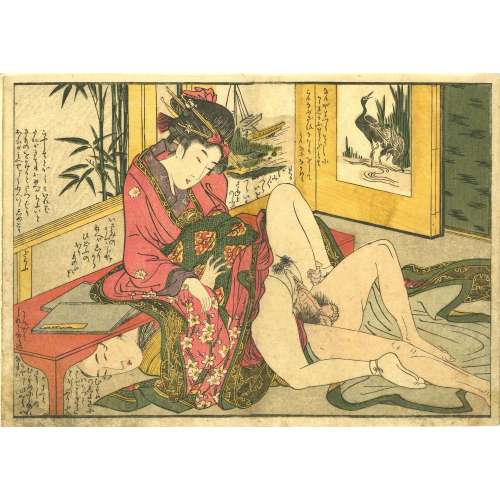 Kitagawa Utamaro. Illustration from book Ehon koi no Onamaki, published in 1799. Reference found by Chris Uhlenbeck: he found one of the designs in Hayashi Yoshikazu's 20-volume set Edo makura-e shi shusei: Kitagawa Utamaro. Size: Chuban (25.5 x 18.5 cm), two book pages glued together.
Kitagawa Utamaro. Illustration from book Ehon koi no Onamaki, published in 1799. Reference found by Chris Uhlenbeck: he found one of the designs in Hayashi Yoshikazu's 20-volume set Edo makura-e shi shusei: Kitagawa Utamaro. Size: Chuban (25.5 x 18.5 cm), two book pages glued together. -
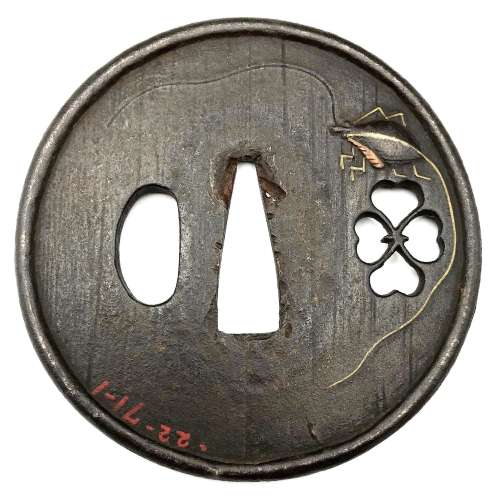 Iron tsuba of round form with a Marsilea (water clover, paddy plant, denjiso) in openwork (sukashi) and a cricket carved in low relief (katakiribori) with extremities and one antenna inlaid with brass; the other antenna is carved in kebori (which antenna is inlaid and which is carved alternates on the face and on the reverse). The plate decorated with vertical file stroke ornamentation (tate-yasurime). Raised dam-shaped rim (dote-mimi). Inscription from a previous collector in red oil paint: 22-71-1. Edo period, possibly 17th century. Katchushi school.
Iron tsuba of round form with a Marsilea (water clover, paddy plant, denjiso) in openwork (sukashi) and a cricket carved in low relief (katakiribori) with extremities and one antenna inlaid with brass; the other antenna is carved in kebori (which antenna is inlaid and which is carved alternates on the face and on the reverse). The plate decorated with vertical file stroke ornamentation (tate-yasurime). Raised dam-shaped rim (dote-mimi). Inscription from a previous collector in red oil paint: 22-71-1. Edo period, possibly 17th century. Katchushi school.Size: 75.0 x 74.4 x 3.6 (center), 5.0 (rim) mm.
The plant Marsilea (paddy plant, denjiso), common names include water clover and four-leaf clover because the long-stalked leaves have four clover-like lobes and are either held above water or submerged. In The elements of Japanese design by John W. Dower, this motif is listed under the numbers 634-35 Paddy Plant (denjiso). Obviously, as a four-leaf clover it is an auspicious symbol. The four leaves radiate out as the shape of the kanji 田 (romaji 'ta'), which means 'rice paddy'. This symbol may be used as a family crest (mon), and this would be the most probable explanation of the sukashi on this tsuba. -
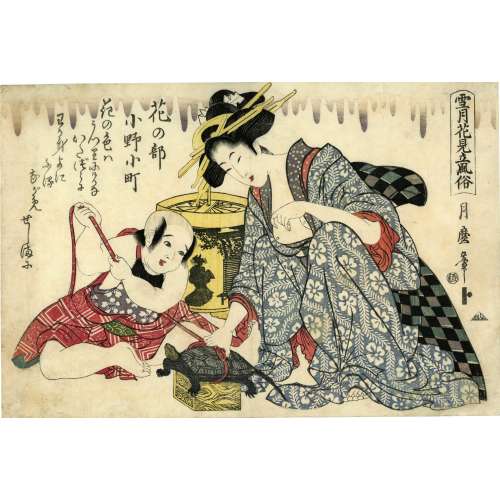
Kitagawa Tsukimaro (Kikumaro): 喜多川 月麿, fl. c. 1794–1836.
Mother is playing with her child: they left playing with shadow lantern for freeing a turtle (Hojo-e, or "Rite for the Release of Living Beings").Signed: Tsukimaro hitsu (月麿筆); Publisher's mark; censor's seal: Kiwame + Yamaguchiya Tôbei gyōji seal (1811-14).
-
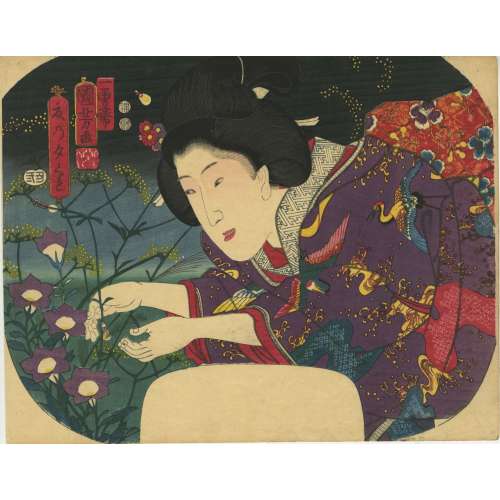 Artist: Utagawa Kuniyoshi [歌川 國芳] (Japanese, 1798 – 1861). Publisher: Enshuya Matabei [遠州屋又兵衛] (Japanese, fl. c. 178 – 1881) – no seal, ref: Kunisada Project. Title: A Summer Evening [夏乃夕暮] (Natsu no Yūgure). A young woman in purple kimono decorated with cranes and waves catching a firefly among yellow and purple flowers. Signed: Ichiyosai Kuniyoshi ga [一勇斎 国芳 画] in a red cartouche and sealed with paulownia (kiri mon). Date seal and double nanushi censor seals: Fuku & Muramatsu, 1853 (Kaei 6, 2nd month). No publisher's seal. Size: Uchiwa-e (untrimmed fan print) 228 x 296 mm. The yellow flower is probably Patrinia scabiosifolia (ominaeshi) [女郎花]. The purple flower seems to be Platycodon grandiflorus or Balloon Flower (kikyō) [桔梗]. Besides, there are visible panicles of Miscanthus sinensis, or Japanese pampas grass (susuki) [薄]. These three are part of the Seven Grasses of Autumn (aki no nanakusa) [秋の七草].
Artist: Utagawa Kuniyoshi [歌川 國芳] (Japanese, 1798 – 1861). Publisher: Enshuya Matabei [遠州屋又兵衛] (Japanese, fl. c. 178 – 1881) – no seal, ref: Kunisada Project. Title: A Summer Evening [夏乃夕暮] (Natsu no Yūgure). A young woman in purple kimono decorated with cranes and waves catching a firefly among yellow and purple flowers. Signed: Ichiyosai Kuniyoshi ga [一勇斎 国芳 画] in a red cartouche and sealed with paulownia (kiri mon). Date seal and double nanushi censor seals: Fuku & Muramatsu, 1853 (Kaei 6, 2nd month). No publisher's seal. Size: Uchiwa-e (untrimmed fan print) 228 x 296 mm. The yellow flower is probably Patrinia scabiosifolia (ominaeshi) [女郎花]. The purple flower seems to be Platycodon grandiflorus or Balloon Flower (kikyō) [桔梗]. Besides, there are visible panicles of Miscanthus sinensis, or Japanese pampas grass (susuki) [薄]. These three are part of the Seven Grasses of Autumn (aki no nanakusa) [秋の七草]. -
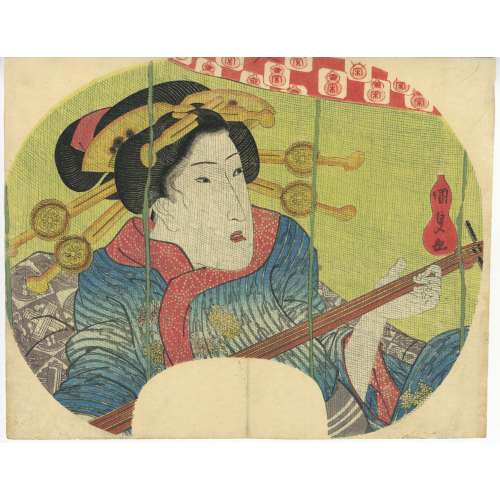 Artist: Utagawa Kunisada [歌川 国貞] a.k.a. Utagawa Toyokuni III [三代歌川豊国] (Japanese, 1786 – 1865). Signed: Kunisada ga [国貞画] in a red double-gourd cartouche Publisher: Unknown (no seal). Date: c. 1832 Izzard: "... red cloth decorated with the characters Yauan, one of Ichikawa Danjūrō VII [市川団十郎] (Japanese, 1791 – 1859) poetry names, and the name of his residence in Fukagawa. The absence of publisher's emblem and censorship seals may indicate that this was a privately issued print, not for public use". Ref.: [LIB-2967.2022] Utagawa Kunisada (1786 – 1865): His world revisited / Catalogue № 17, Exhibition March 17-21, 2021. — NY: Sebastian Izzard, LLC., 2021; p. 112-3, fig. 32). Size: Fan print (aiban uchiwa-e); 235 x 295 mm.
Artist: Utagawa Kunisada [歌川 国貞] a.k.a. Utagawa Toyokuni III [三代歌川豊国] (Japanese, 1786 – 1865). Signed: Kunisada ga [国貞画] in a red double-gourd cartouche Publisher: Unknown (no seal). Date: c. 1832 Izzard: "... red cloth decorated with the characters Yauan, one of Ichikawa Danjūrō VII [市川団十郎] (Japanese, 1791 – 1859) poetry names, and the name of his residence in Fukagawa. The absence of publisher's emblem and censorship seals may indicate that this was a privately issued print, not for public use". Ref.: [LIB-2967.2022] Utagawa Kunisada (1786 – 1865): His world revisited / Catalogue № 17, Exhibition March 17-21, 2021. — NY: Sebastian Izzard, LLC., 2021; p. 112-3, fig. 32). Size: Fan print (aiban uchiwa-e); 235 x 295 mm. -
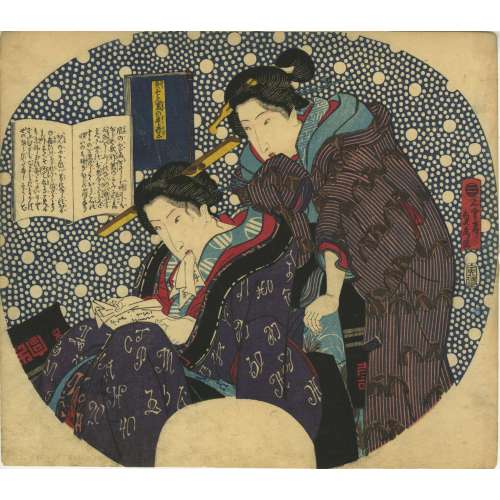 Artist: Utagawa Sadahide [歌川 貞秀], a.k.a. Gountei Sadahide [五雲亭 貞秀] (1807 – c. 1878/9). Signed: Gountei Sadahide ga [五雲亭貞秀画] Pubisher: Ibaya Senzaburō [伊場屋仙三郎] (Japanese, 1815 – 1869) Date-aratame seal: Bunsei 13 / Tenpō 1 (1830). Ref: Ritsumeikan University # Z0172-587. Title: The tatami night robe of Iwao [巌の畳夜着] (Kyusue Iwao no tatami yogi); 灸すゑ巌の畳夜着(きゅうすえいわおのたたみよぎ。「灸すえ」– one of the main melodies in katōbushi (河東節) type of jōruri [浄瑠璃]. For a detailed explanation in Japanese, see also HERE). The night robe of Iwao is decorated with characters resembling Arabic numerals, and Latin and Cyrillic letters. A similar kimono can be seen on Kunisada's print Hotoke Gozen, Mirror of Virtuous and Wise Women (Kenjo Kagami) at RISD museum accession number 13.1383, portraying Hotoke Gozen (佛御前), a character of The Tale of the Heike [平家物語] (Heike Monogatari); published by Yamamotoya Heikichi (山本屋平吉) (Japanese, fl. c. 1812 – 1886) in the 1830s (see below).A series of three prints is dedicated to a katōbushi performance of the Soga-themed plays.
Artist: Utagawa Sadahide [歌川 貞秀], a.k.a. Gountei Sadahide [五雲亭 貞秀] (1807 – c. 1878/9). Signed: Gountei Sadahide ga [五雲亭貞秀画] Pubisher: Ibaya Senzaburō [伊場屋仙三郎] (Japanese, 1815 – 1869) Date-aratame seal: Bunsei 13 / Tenpō 1 (1830). Ref: Ritsumeikan University # Z0172-587. Title: The tatami night robe of Iwao [巌の畳夜着] (Kyusue Iwao no tatami yogi); 灸すゑ巌の畳夜着(きゅうすえいわおのたたみよぎ。「灸すえ」– one of the main melodies in katōbushi (河東節) type of jōruri [浄瑠璃]. For a detailed explanation in Japanese, see also HERE). The night robe of Iwao is decorated with characters resembling Arabic numerals, and Latin and Cyrillic letters. A similar kimono can be seen on Kunisada's print Hotoke Gozen, Mirror of Virtuous and Wise Women (Kenjo Kagami) at RISD museum accession number 13.1383, portraying Hotoke Gozen (佛御前), a character of The Tale of the Heike [平家物語] (Heike Monogatari); published by Yamamotoya Heikichi (山本屋平吉) (Japanese, fl. c. 1812 – 1886) in the 1830s (see below).A series of three prints is dedicated to a katōbushi performance of the Soga-themed plays.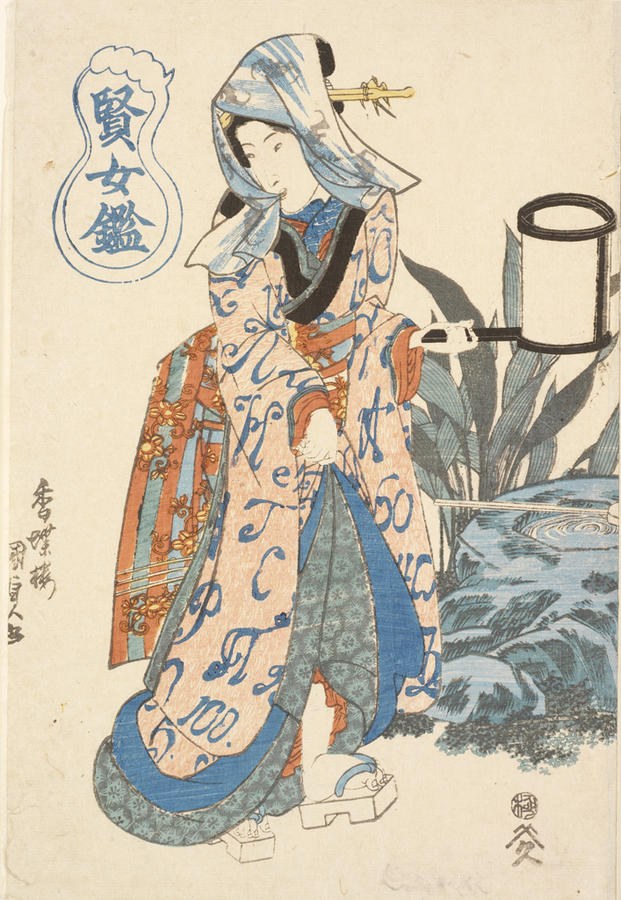
RISDM 13-1383
They all have a background of hail patterns (Arare-ko-mon) [霰小紋], similar to Kunisada’s Iwai Kumesaburō II as An no Heibei [SVJP-0304.2019], see below.Yukari no Edo-zakura The tatami night robe of Iwao Tangled Hair and the Evening Braided Hat 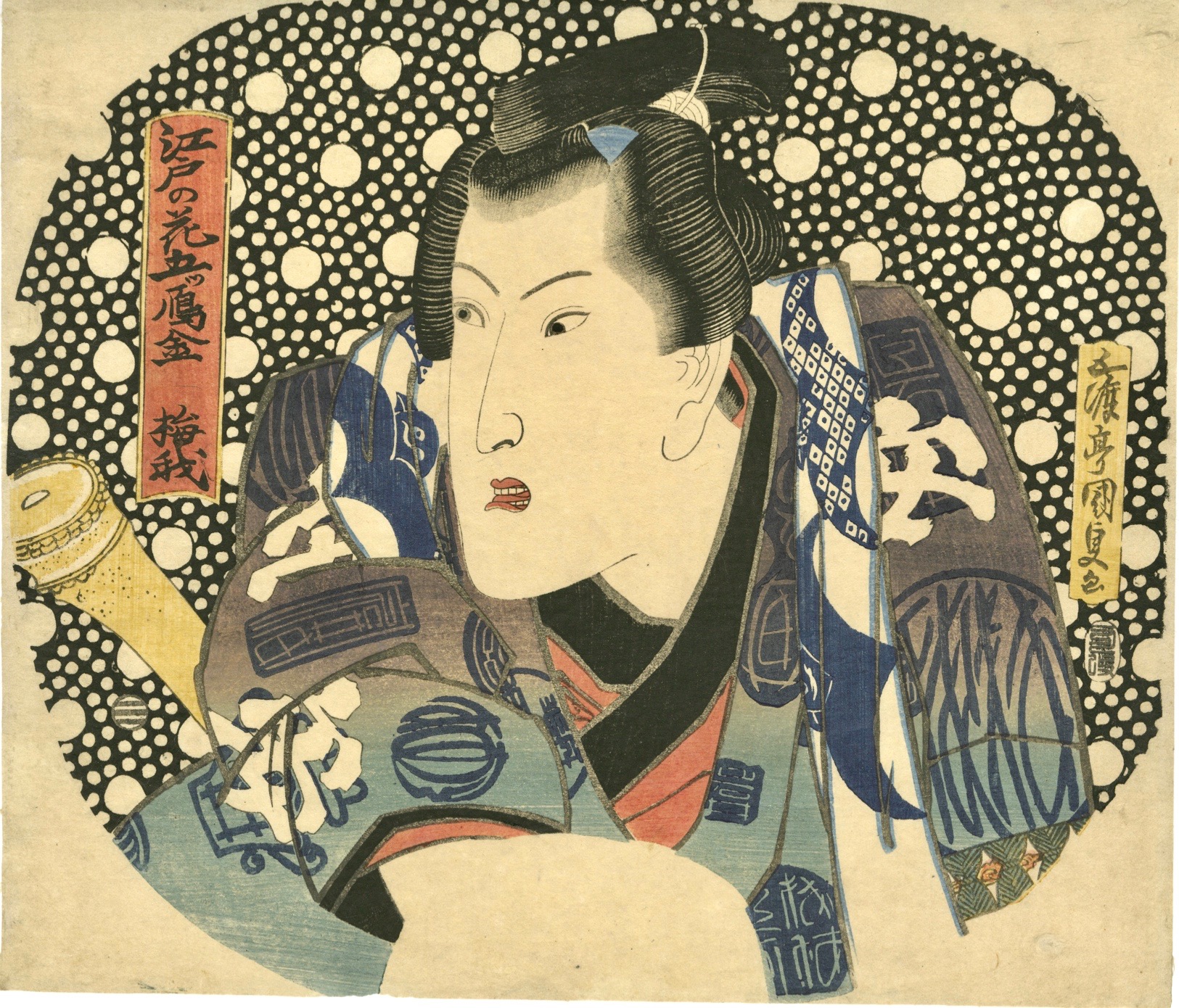
-
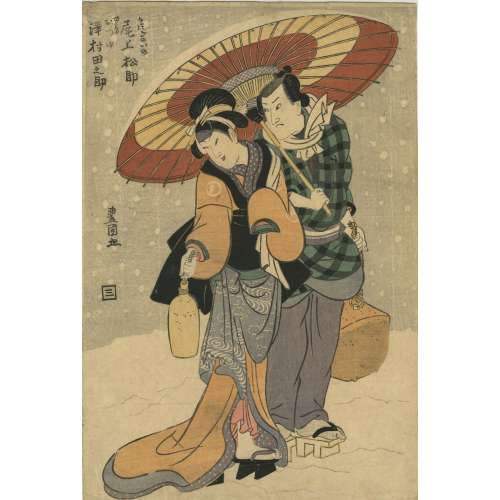 Utagawa Toyokuni (歌川豐國); 1769 – 24 February 1825. Actor Onoe Matsusuke II as Katsugiino (right), actor Sawamura Tanosuke II as Otsuyu (left) 尾上松助(二代目)in a role かつぎいの; 沢村田之助(二代目) in a role おつゆ. Play: "Yuki to Tsuki Hana no Kuronushi". Theater: Nakamura. Publisher: Mikawaua Seiemon (1805-1829) [Marks: 328]. Circa 1810.
Utagawa Toyokuni (歌川豐國); 1769 – 24 February 1825. Actor Onoe Matsusuke II as Katsugiino (right), actor Sawamura Tanosuke II as Otsuyu (left) 尾上松助(二代目)in a role かつぎいの; 沢村田之助(二代目) in a role おつゆ. Play: "Yuki to Tsuki Hana no Kuronushi". Theater: Nakamura. Publisher: Mikawaua Seiemon (1805-1829) [Marks: 328]. Circa 1810. -
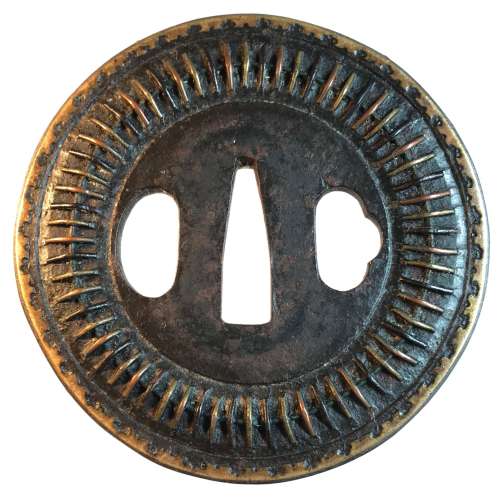 Iron tsuba of round form inlaid with brass, copper, and shakudō wire fastened to the surface with metal staples (mukade-zōgan); Scalloped brass inlay around the rim. Early Edo, 17th century. Height: 84.8 mm; Width 84.8 mm; Thickness at seppa-dai: 3.7 mm. Weight 161.6 g. Design is thought to resemble a centipede. "Centipede-like inlay (mukade zogan) of alternating iron and brass staples produce an appearance that was particularly favored by Takeda Shingen (1521-1573), one of the most powerful warlords of his time. The centipede is sacred to Bishamon (God of War) and especially propitious for a warrior. Shingen type, 16th century.” [The Peabody Museum collection of Japanese sword guards with selected pieces of sword furniture, by John D. Hamilton. Photographs by Mark Sexton. Salem, MA, 1975.] See also: http://varshavskycollection.com/shingen-tsuba/
Iron tsuba of round form inlaid with brass, copper, and shakudō wire fastened to the surface with metal staples (mukade-zōgan); Scalloped brass inlay around the rim. Early Edo, 17th century. Height: 84.8 mm; Width 84.8 mm; Thickness at seppa-dai: 3.7 mm. Weight 161.6 g. Design is thought to resemble a centipede. "Centipede-like inlay (mukade zogan) of alternating iron and brass staples produce an appearance that was particularly favored by Takeda Shingen (1521-1573), one of the most powerful warlords of his time. The centipede is sacred to Bishamon (God of War) and especially propitious for a warrior. Shingen type, 16th century.” [The Peabody Museum collection of Japanese sword guards with selected pieces of sword furniture, by John D. Hamilton. Photographs by Mark Sexton. Salem, MA, 1975.] See also: http://varshavskycollection.com/shingen-tsuba/ -
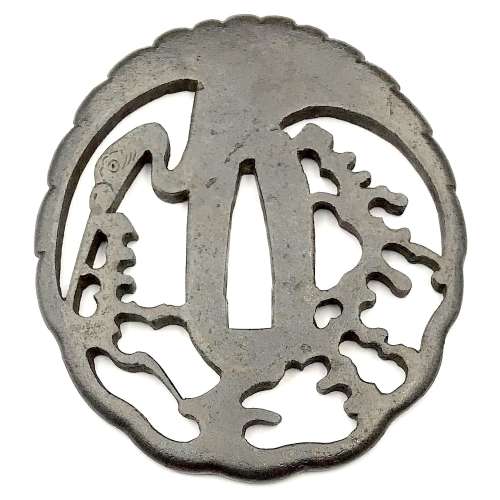
Iron tsuba of round form (tsurumaru) decorated with a design of crane and pines, or "nesting crane (sugomori-tsuru)" in openwork (sukashi). Details carved in kebori. Rounded rim.
Size: 74.7 x 69.8 x 4.8 mm.
Unsigned.
Edo period, ca. 17th century.
NBTHK Certificate № 463485. The certificate says it's a Higo School piece. The design was popular in both Akasaka and Higo schools. The Akasaka example: at Kodogu and tsuba. International collections not published in my books. (Toso Soran). Ph. D. Kazutaro Torigoye, 1978, p. 246: "Late Edo. Jiyūgata. Sined: Akasaka Tadanori saku."The Higo example can be found at Iron tsuba. The works of the exhibition "Kurogane no hana", The Japanese Sword Museum, 2014, p. 69, №56: Sugomori-tsuru sukashi-tsuba (Nesting Carne). Mumei: Matashichi (1st generation), early 17th century.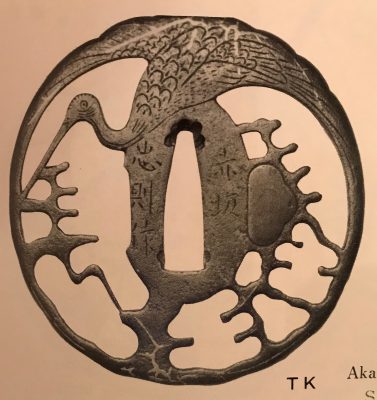
Torigoye, 1978, p. 246. Late Akasaka.
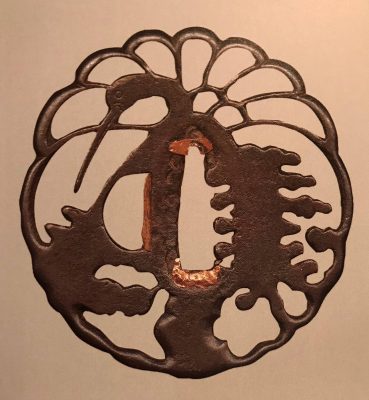
Kurogane no hana, 2014, p. 69, №56. Higo tsuba.
-
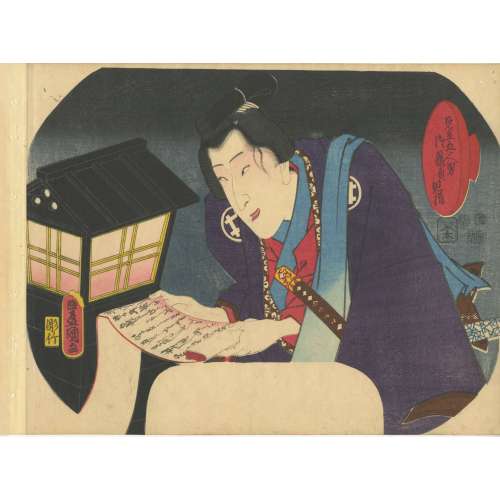 Utagawa Kunisada [歌川 国貞] a.k.a. Utagawa Toyokuni III [三代歌川豊国] (Japanese, 1786 – 1865).
Utagawa Kunisada [歌川 国貞] a.k.a. Utagawa Toyokuni III [三代歌川豊国] (Japanese, 1786 – 1865).Uncut fan print (uchiwa-e), 295 x 230 mm, depicting kabuki actor Bandō Shūka I as Shirai Gonpachi (白井権八) reading a scroll by the light of a lantern. From the series A Parody of the Five Chivalrous Commoners; a Cup of Sake From Their Fans (Mitate gonin otoko, go-hiiki no omoizashi). According to Paul Griffith, the term omoizashi refers to the act of pouring a cup of sake for one's chosen partner, here giving an impression of intimacy and affection between famous actors and their patrons.
Actor: Bandō Shūka I [初代坂東しうか] (Japanese, 1813-1855); other names: Bandō Tamasaburō I, Bandō Mitsugorō V (posthumously). The print was probably published by some unknown Yama-Ta (Marks U421b). Double nanushi censor seals and date seal: Muramatsu and Fuku, Kaei 5, 2nd month (2/1852). As Kabuki Encyclopedia put it: "Gonpachi. A parasite. From the character named Shirai Gonpachi who lives at the home of Banzui Chōbei and sponges off him" (An English-Langauge Adaptation of Kabuki Jiten. Samuel L. Leiter. Greenwood Press, 1979, pp. 26, 98-9). There were many kabuki plays based on the story of the lovers Miura-ya Komurasaki and Shirai Gonpachi. (See: [LIB-2226.2019] Algernon Bertram Freeman-Mitford. Tales of Old Japan. — London: Macmillan and Co., 1883). Ref.: Art shop Ezoshi Ukiyoe new collection news, vol. 66, 2023.1 (Jan) # 31, p.8. -
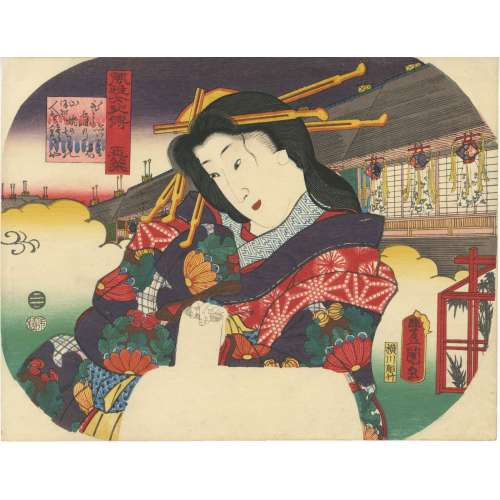 Artist: Utagawa Kunisada [歌川 国貞], a.k.a. Utagawa Toyokuni III [三代 歌川 豊国] (Japanese, 1786 – 1865). Signed: Toyokuni ga [豊国 画] in a red toshidama cartouche Block carver: Yokokawa Takejirō [横川竹二郎] (Japanese, fl. 1845 – 1863), seal: 彫竹 – hori Take. Publisher: Ibaya Senzaburō [伊場屋仙三郎] (Japanese, fl. c. 1845 – 1847). Media: Untrimmed fan print (uchiwa-e), 232 x 300 mm. Title: Tamagiku [玉菜]. Series: Chronicles of Elegant Women [風雅女史傳] (Fūga joshiden). Combined date seal and kiwame censor seal: Ansei 6 (1859). Other prints from the same series in this collection [SVJP-0216.2016] — Princess Sotoori:
Artist: Utagawa Kunisada [歌川 国貞], a.k.a. Utagawa Toyokuni III [三代 歌川 豊国] (Japanese, 1786 – 1865). Signed: Toyokuni ga [豊国 画] in a red toshidama cartouche Block carver: Yokokawa Takejirō [横川竹二郎] (Japanese, fl. 1845 – 1863), seal: 彫竹 – hori Take. Publisher: Ibaya Senzaburō [伊場屋仙三郎] (Japanese, fl. c. 1845 – 1847). Media: Untrimmed fan print (uchiwa-e), 232 x 300 mm. Title: Tamagiku [玉菜]. Series: Chronicles of Elegant Women [風雅女史傳] (Fūga joshiden). Combined date seal and kiwame censor seal: Ansei 6 (1859). Other prints from the same series in this collection [SVJP-0216.2016] — Princess Sotoori: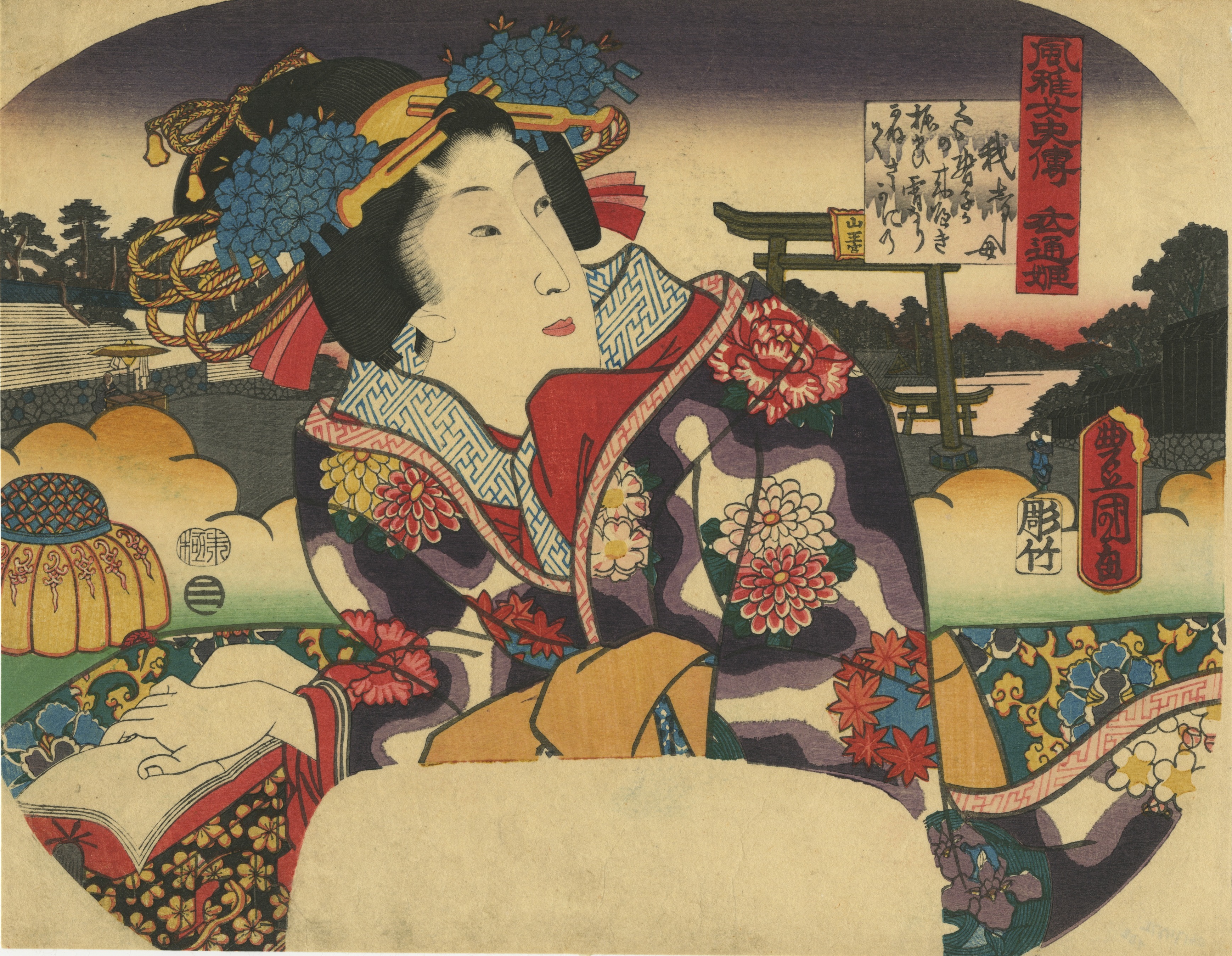 SVJP-0400.2023 — Saiko:
SVJP-0400.2023 — Saiko:
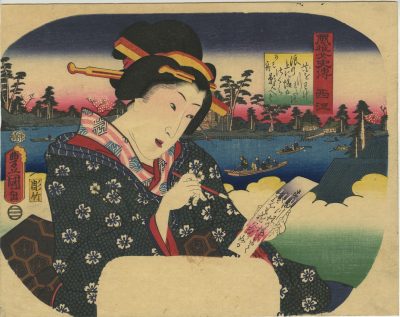 Note by Elena Varshavsky:
Tamagiku [玉菜] (Japanese, 1702 – 1726) – Precious Chrysanthemum (translated also as Jade Chrysanthemum; one can say also Gem Chrysanthemum). She was a courtesan famous for her beauty, kind heart, and countless artistic accomplishments. She died young and was deeply grieved by the establishment of Nakamanji-ya (中万字屋) for which she worked, and beyond. Her memory was celebrated during the Bon festival of the commemoration of the dead, and lanterns were hung at the gallery of that establishment and other neighbouring ones to commemorate her and appease her soul. These lanterns are seen behind her. Kabuki plays were continuously dedicated to her, she figured in Edo period literature and was often portrayed on ukiyo-e prints. In many cases, she was shown with the lanterns associated with her. Those lanterns were called “Tamagiku Lanterns”.
Other depictions of Tamagiku:
Note by Elena Varshavsky:
Tamagiku [玉菜] (Japanese, 1702 – 1726) – Precious Chrysanthemum (translated also as Jade Chrysanthemum; one can say also Gem Chrysanthemum). She was a courtesan famous for her beauty, kind heart, and countless artistic accomplishments. She died young and was deeply grieved by the establishment of Nakamanji-ya (中万字屋) for which she worked, and beyond. Her memory was celebrated during the Bon festival of the commemoration of the dead, and lanterns were hung at the gallery of that establishment and other neighbouring ones to commemorate her and appease her soul. These lanterns are seen behind her. Kabuki plays were continuously dedicated to her, she figured in Edo period literature and was often portrayed on ukiyo-e prints. In many cases, she was shown with the lanterns associated with her. Those lanterns were called “Tamagiku Lanterns”.
Other depictions of Tamagiku:
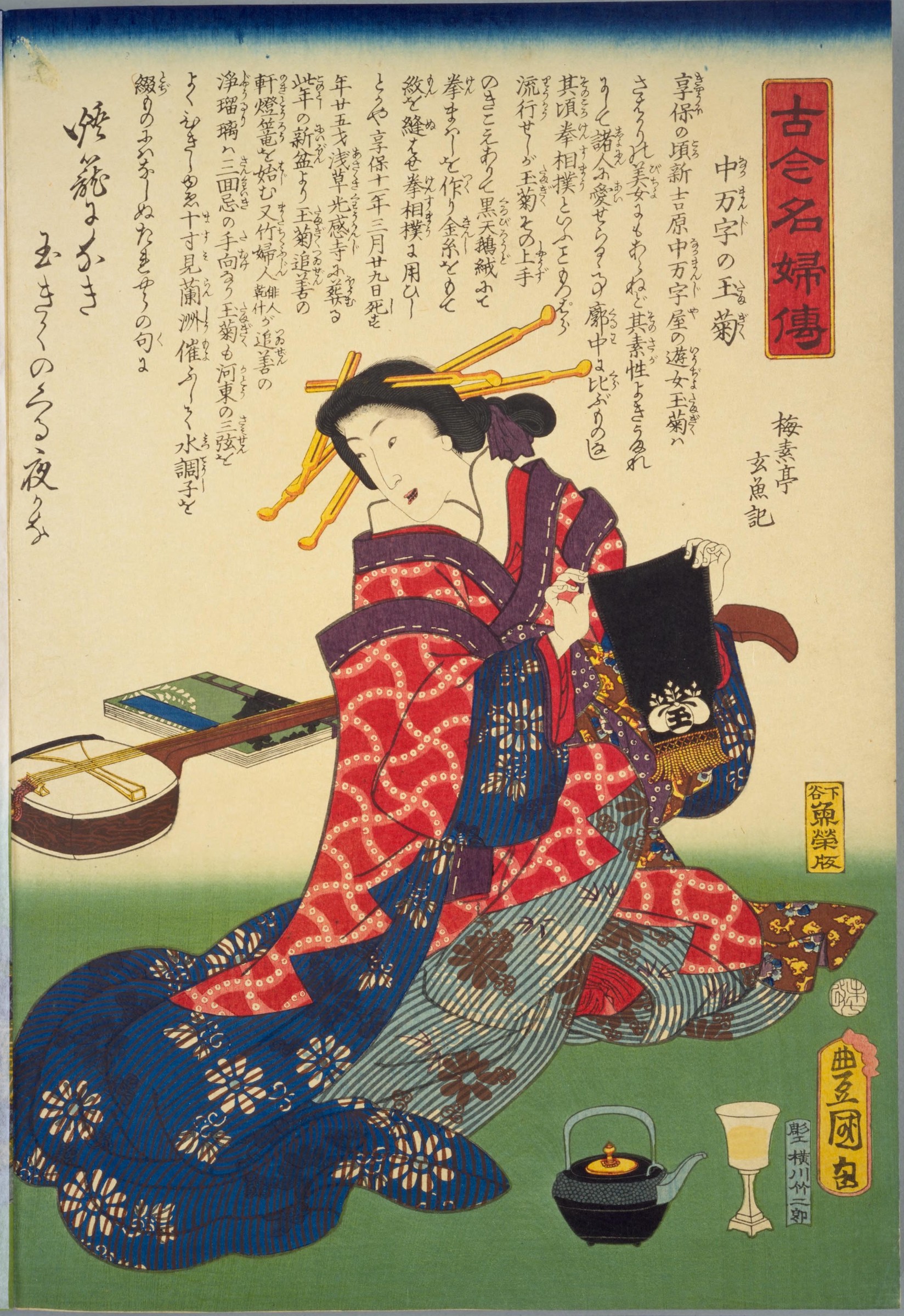
Tamagiku (Ancient and modern women's biography) by Kunisada, 1859.
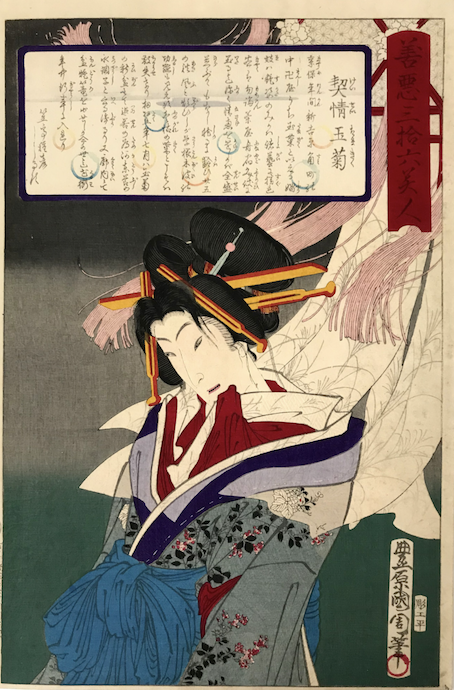
Courtesan Tamagiku by Kunichika.
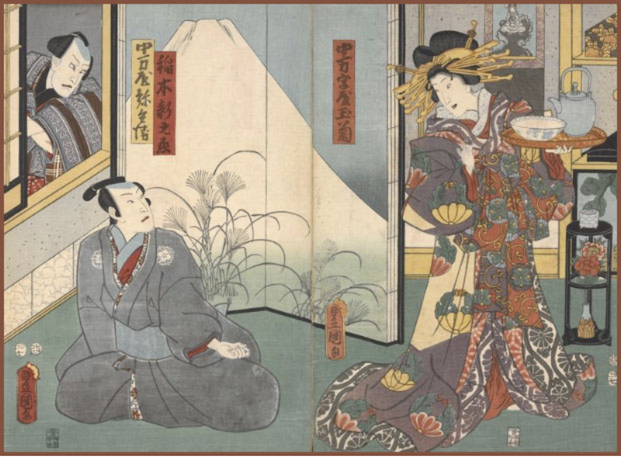
Tamagiku of the Nakamanjiya, Inaki Shinnojō, and Nakamanjiya Yahei (looking through the window) by Kunisada.

Nakamanji-Ya Tamagiku by Kunisada
Sources: darumapedia; kajiipeta; kabuki21; crosseyedgallery.
Nakamanji-Ya Tamagiku by Kunisada, 1857
-
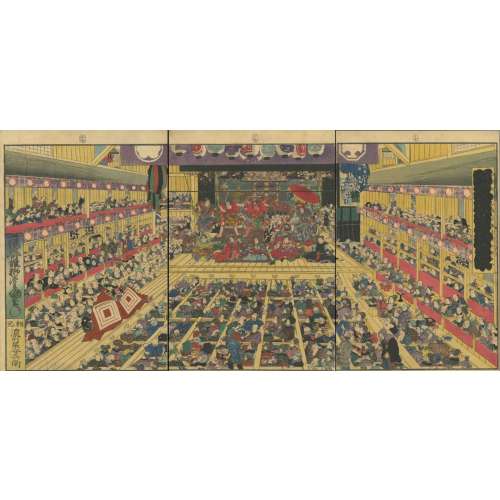 Superb Edo pictures illustrating dances (Odori keiyô Edo-e no sakae): Interior of an imaginary theatre with a performance of Shibaraku 「踊形容江戸絵栄」. Artist: Utagawa Kunisada [歌川 国貞] a.k.a. Utagawa Toyokuni III [三代歌川豊国] (Japanese, 1786 – 1865). Publisher: Nōshūya Yasubei (Japanese, fl. c. 1851 – 1870). Year: 1858 (Ansei 5), 7th month. Size: Vertical ôban triptych; 36.9 x 75.7 cm. Signed: 一陽斎雛獅豊国筆(年玉印) – Ichiyôsai Hinashi Toyokuni ga (on the left sheet only). Censor's seal: Horse 7 [午七 彫師]. Subject: Shibaraku. Ref.: MFA impression: 11.44263a-c; Robert Schaap. Kunisada (2016), p. 101 [LIB-1212.2017]. Ref.: [LIB-1197.2016] Arendie and Henk Herwig. Heroes of the Kabuki stage: an introduction to Kabuki with retellings of famous plays, illustrated by woodblock prints. — Amsterdam: Hotei Publishing, 2004; p. 38. [LIB-3316.2024] Chris Uhlenbeck, Jim Dwinger, Josephine Smit. The Riddles of Ukiyo-e: Women and Men in Japanese Prints. — Brussels: Ludion, 2023, p. 218-9, № 107.
Superb Edo pictures illustrating dances (Odori keiyô Edo-e no sakae): Interior of an imaginary theatre with a performance of Shibaraku 「踊形容江戸絵栄」. Artist: Utagawa Kunisada [歌川 国貞] a.k.a. Utagawa Toyokuni III [三代歌川豊国] (Japanese, 1786 – 1865). Publisher: Nōshūya Yasubei (Japanese, fl. c. 1851 – 1870). Year: 1858 (Ansei 5), 7th month. Size: Vertical ôban triptych; 36.9 x 75.7 cm. Signed: 一陽斎雛獅豊国筆(年玉印) – Ichiyôsai Hinashi Toyokuni ga (on the left sheet only). Censor's seal: Horse 7 [午七 彫師]. Subject: Shibaraku. Ref.: MFA impression: 11.44263a-c; Robert Schaap. Kunisada (2016), p. 101 [LIB-1212.2017]. Ref.: [LIB-1197.2016] Arendie and Henk Herwig. Heroes of the Kabuki stage: an introduction to Kabuki with retellings of famous plays, illustrated by woodblock prints. — Amsterdam: Hotei Publishing, 2004; p. 38. [LIB-3316.2024] Chris Uhlenbeck, Jim Dwinger, Josephine Smit. The Riddles of Ukiyo-e: Women and Men in Japanese Prints. — Brussels: Ludion, 2023, p. 218-9, № 107. -
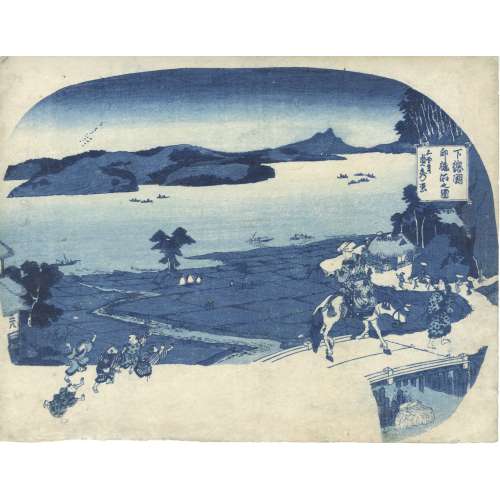 An uncut aizuri fan print showing travellers arriving at Inba Lake [印旛沼] (Inba-numa) on Shimosa Plateau [下総台地] (Shimōsa-daichi). Artist: Utagawa Sadahide [歌川貞秀] (Japanese, 1807 – 1879) Publisher: Unknown. Published: c. 1849. Signed: Gountei Sadahide ga [五雲亭 貞秀画] (Picture by Gountei Sadahide). Inscription in cartouche: Shimosa Plateau, Inbanuma (Inba Lake) [下總國印幡沼]. No date seal, no censor seal (privately printed?) Media: Fan print [団扇絵] (uchiwa-e), 235 x 300 mm.
An uncut aizuri fan print showing travellers arriving at Inba Lake [印旛沼] (Inba-numa) on Shimosa Plateau [下総台地] (Shimōsa-daichi). Artist: Utagawa Sadahide [歌川貞秀] (Japanese, 1807 – 1879) Publisher: Unknown. Published: c. 1849. Signed: Gountei Sadahide ga [五雲亭 貞秀画] (Picture by Gountei Sadahide). Inscription in cartouche: Shimosa Plateau, Inbanuma (Inba Lake) [下總國印幡沼]. No date seal, no censor seal (privately printed?) Media: Fan print [団扇絵] (uchiwa-e), 235 x 300 mm.



